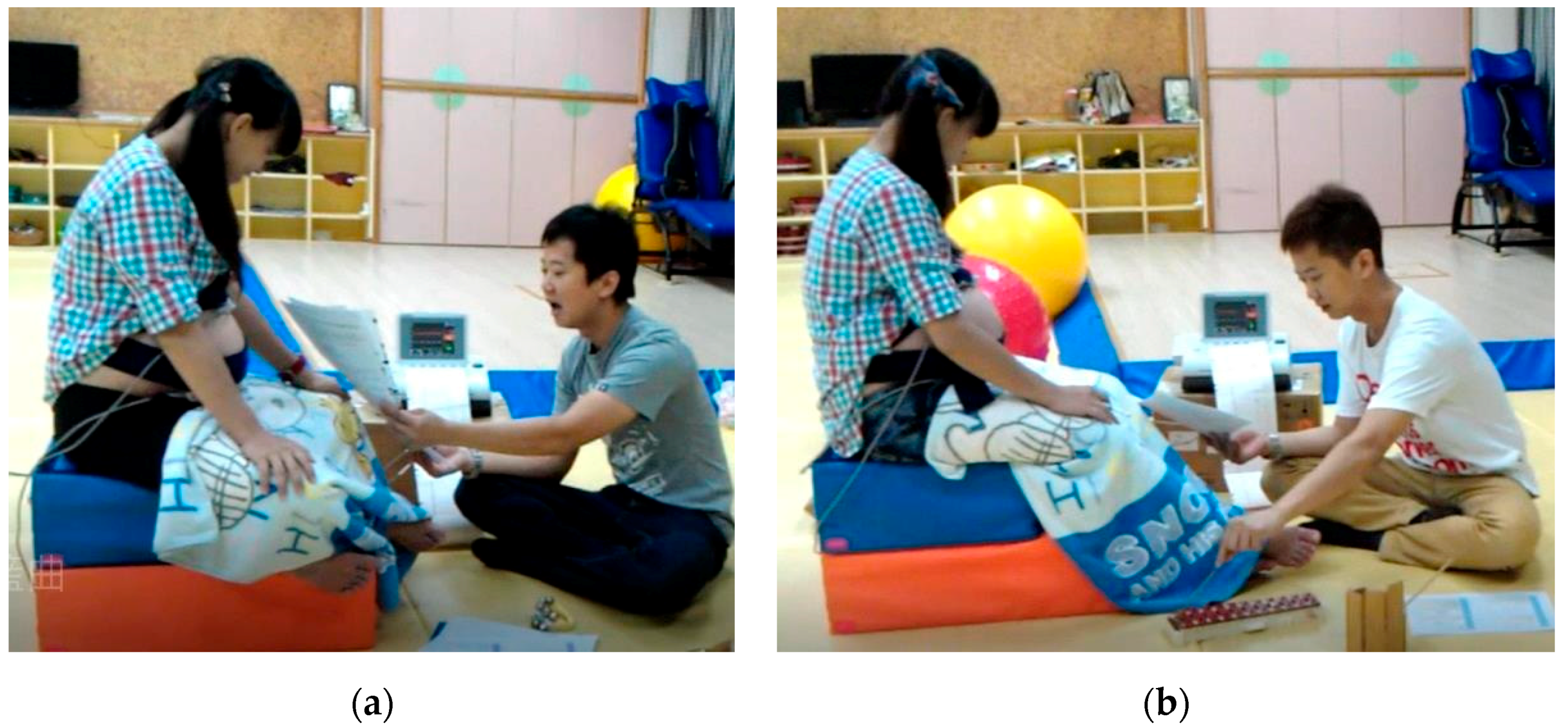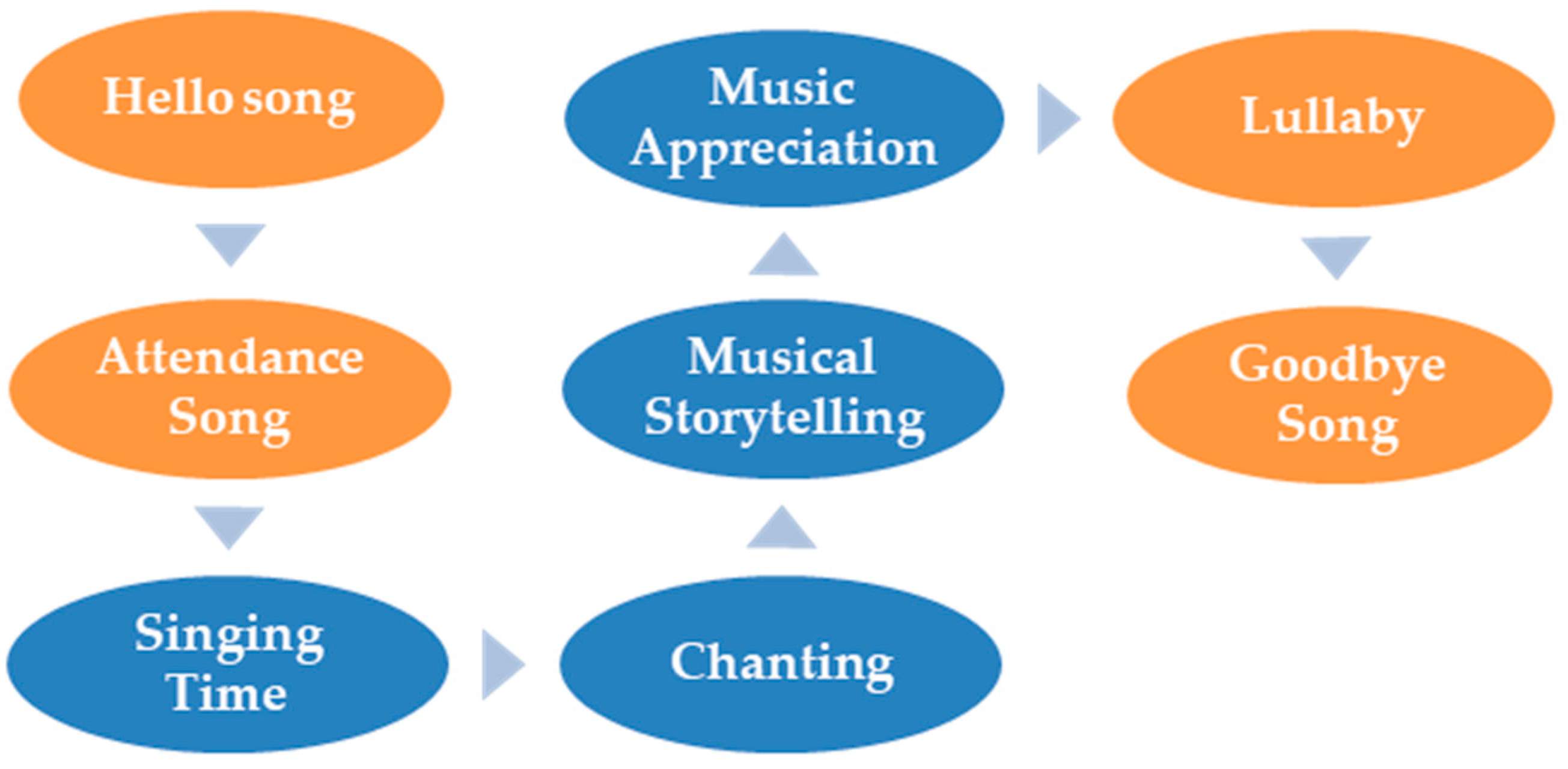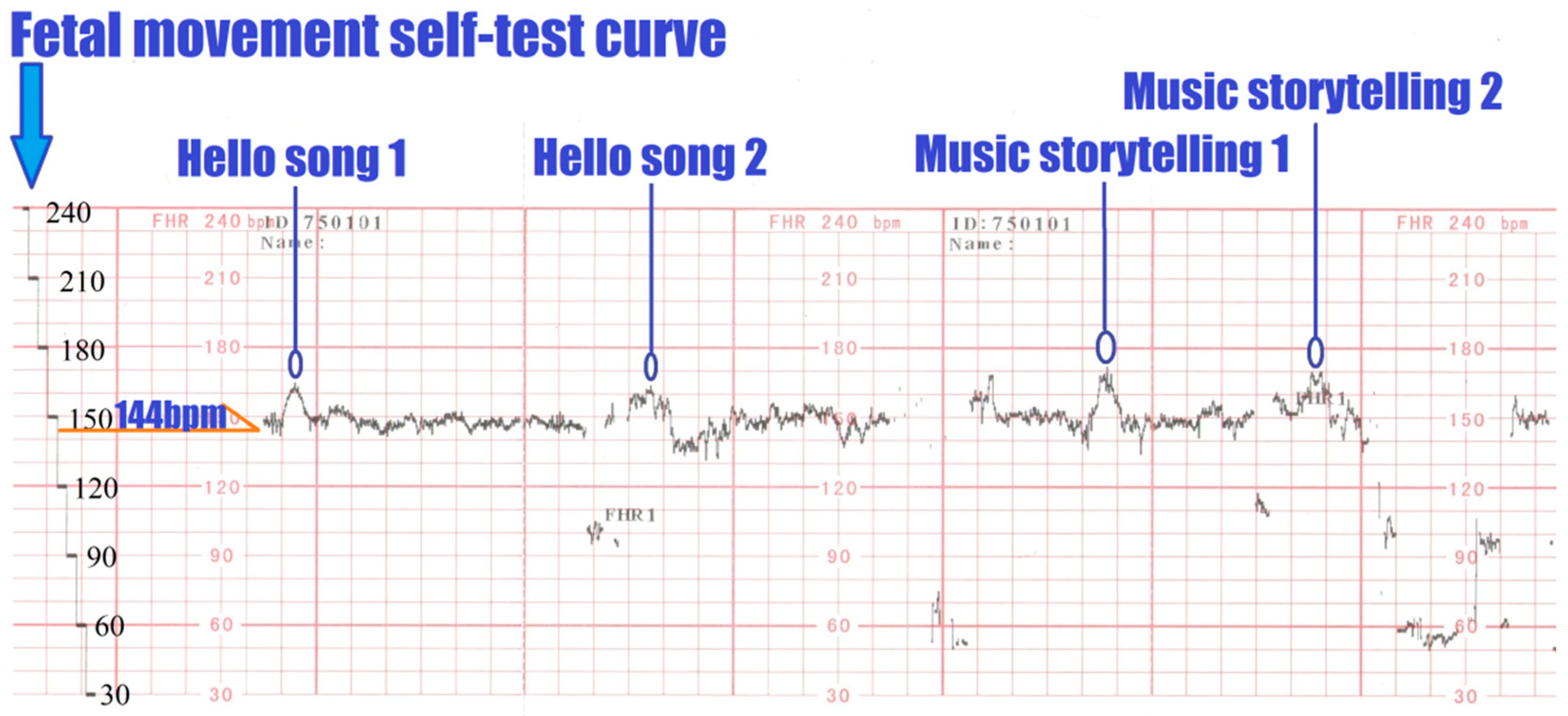The Effect of Music Intervention on Fetal Education via Doppler Fetal Monitor
Abstract
:1. Introduction
2. Methods
2.1. Participants
2.2. Research Design
2.3. The Curriculum Design
2.3.1. Hello Song and Goodbye Song
2.3.2. Attendance Song
2.3.3. Singing Time and Chanting
2.3.4. Musical Storytelling
2.3.5. Music Appreciation
2.3.6. Lullaby
2.4. Assessment
2.5. Statistical Methods
3. Results
4. Discussion and Conclusions
Author Contributions
Funding
Institutional Review Board Statement
Informed Consent Statement
Data Availability Statement
Conflicts of Interest
References
- Eleftheriades, M.; Vousoura, E.; Eleftheriades, A.; Pervanidou, P.; Zervas, I.M.; Chrousos, G.; Vlahos, N.F.; Sotiriadis, A. Physical Health, Media Use, Stress, and Mental Health in Pregnant Women during the COVID-19 Pandemic. Diagnostics 2022, 12, 1125. [Google Scholar] [CrossRef] [PubMed]
- Preis, H.; Mahaffey, B.; Heiselman, C.; Lobel, M. Vulnerability and resilience to pandemic-related stress among U.S. women pregnant at the start of the COVID-19 pandemic. Soc. Sci. Med. 2020, 266, 113348. [Google Scholar] [CrossRef] [PubMed]
- Biaggi, A.; Conroy, S.; Pawlby, S.; Pariante, C.M. Identifying the women at risk of antenatal anxiety and depression: A systematic review. J. Affect. Disord. 2016, 191, 62–77. [Google Scholar] [CrossRef] [PubMed] [Green Version]
- Preis, H.; Mahaffey, B.; Heiselman, C.; Lobel, M. Pandemic-related pregnancy stress and anxiety among women pregnant during the coronavirus disease 2019 pandemic. Am. J. Obstet. Gynecol. MFM 2020, 2, 100155. [Google Scholar] [CrossRef] [PubMed]
- Wulff, V.; Hepp, P.; Wolf, O.T.; Balan, P.; Hagenbeck, C.; Fehm, T.; Schaal, N.K. The effects of a music and singing intervention during pregnancy on maternal wellbeing and mother–infant bonding: A randomised, controlled study. Arch. Gynecol. Obstet. 2021, 303, 69–83. [Google Scholar] [CrossRef]
- Maddahi, M.S.; Dolatian, M. Correlation of maternal-fetal attachment and health practices during pregnancy with neonatal outcomes. Electron. Physician 2016, 8, 2639. [Google Scholar] [CrossRef] [PubMed] [Green Version]
- McNamara, J.; Townsend, M.L.; Herbert, J.S. A systemic review of maternal wellbeing and its relationship with maternal fetal attachment and early postpartum bonding. PLoS ONE 2019, 14, e0220032. [Google Scholar] [CrossRef]
- Göbel, A.; Stuhrmann, L.Y.; Harder, S.; Schulte-Markwort, M.; Mudra, S. The association between maternal-fetal bonding and prenatal anxiety: An explanatory analysis and systematic review. J. Affect. Disord. 2018, 239, 313–327. [Google Scholar] [CrossRef]
- Rubin, R. Maternal tasks in pregnancy. J. Adv. Nurs. 1976, 1, 367–376. [Google Scholar] [CrossRef]
- Alhusen, J.L. A literature update on maternal-fetal attachment. J. Obstet. Gynecol. Neonatal Nurs. 2008, 37, 315–328. [Google Scholar] [CrossRef] [Green Version]
- Koire, A.; Mittal, L.; Erdei, C.; Liu, C.H. Maternal-fetal bonding during the COVID-19 pandemic. BMC Pregnancy Childbirth 2021, 21, 846. [Google Scholar] [CrossRef] [PubMed]
- Serçekuş, P.; Başkale, H. Effects of antenatal education on fear of childbirth, maternal self-efficacy and parental attachment. Midwifery 2016, 34, 166–172. [Google Scholar] [CrossRef] [PubMed]
- Mangesi, L.; Hofmeyr, G.J.; Smith, V.; Smyth, R.M. Fetal movement counting for assessment of fetal wellbeing. Cochrane Database Syst. Rev. 2015, 1–34. [Google Scholar] [CrossRef] [Green Version]
- Brandon, A.R.; Pitts, S.; Denton, W.H.; Stringer, C.A.; Evans, H. A history of the theory of prenatal attachment. J. Prenat. Perinat. Psychol. Health—APPPAH 2009, 23, 201. [Google Scholar]
- Mikhail, M.S.; Freda, M.C.; Merkatz, R.B.; Polizzotto, R.; Mazloom, E.; Merkatz, I.R. The effect of fetal movement counting on maternal attachment to fetus. Am. J. Obstet. Gynecol. 1991, 165, 988–991. [Google Scholar] [CrossRef]
- Guney, E.; Ucar, T. Effect of the fetal movement count on maternal-fetal attachment. Jpn. J. Nurs. Sci. 2019, 16, 71–79. [Google Scholar] [CrossRef]
- Lumley, J.M. Attitudes to the fetus among primigravidae. J. Paediatr. Child Health 1982, 18, 106–109. [Google Scholar] [CrossRef]
- Hopkins, B.; Geangu, E.; Linkenauger, S. The Cambridge Encyclopedia of Child Development; Cambridge University Press: Cambridge, UK, 2017. [Google Scholar]
- Rand, K.; Lahav, A. Maternal sounds elicit lower heart rate in preterm newborns in the first month of life. Early Hum. Dev. 2014, 90, 679–683. [Google Scholar] [CrossRef] [Green Version]
- Litovsky, R. Development of the auditory system. Handb. Clin. Neurol. 2015, 129, 55–72. [Google Scholar]
- Cirelli, L.K.; Jurewicz, Z.B.; Trehub, S.E. Effects of maternal singing style on mother–infant arousal and behavior. J. Cogn. Neurosci. 2020, 32, 1213–1220. [Google Scholar] [CrossRef]
- Bainbridge, C.M.; Bertolo, M.; Youngers, J.; Atwood, S.; Yurdum, L.; Simson, J.; Lopez, K.; Xing, F.; Martin, A.; Mehr, S.A. Infants relax in response to unfamiliar foreign lullabies. Nat. Hum. Behav. 2021, 5, 256–264. [Google Scholar] [CrossRef] [PubMed]
- Lee, L.; Ho, H.-J. Exploring young children’s communication development through the Soundbeam trigger modes in the ‘Holistic music educational approach for young children’programme. Malays. J. Music. 2018, 7, 1–19. [Google Scholar] [CrossRef]
- Lee, L. An empirical study of holistic music educational approach for young children on communication development. In Proceedings of the 26th European Teacher Education Network (ETEN) Conference, Setúbal, Portugal, 14–17 April 2016. [Google Scholar]
- Lee, L.; Liu, Y.S. Training effects and intelligent evaluated pattern of the holistic music educational approach for children with developmental delay. Int. J. Environ. Res. Public Health 2021, 18, 10064. [Google Scholar] [CrossRef] [PubMed]
- Lee, L.; Ho, H.J. A case study on the development of a child with disabilities and emotional stability by using the holistic music educational approach. In Proceedings of the 22nd International Seminar of the ISME Commission on Special Music Education and Music Therapy, Salzburg, Austria, 12–14 July 2018; pp. 118–131. [Google Scholar]
- Lee, L.; Li, T.Y. The impact of music activities in a multi-sensory room for children with multiple disabilities on developing positive emotions: A case study. J. Eur. Teach. Educ. Netw. 2016, 11, 1–12. [Google Scholar]
- Lee, L.; Ho, H.-J.; Liao, X.-D.; Liao, Y.-X.; Chu, H.-C. The impact of using FigureNotes for young children with developmental delay on developing social interactions and physical movements. In Proceedings of the 2019 IEEE International Conference on Consumer Electronics-Taiwan (ICCE-TW), Yilan, Taiwan, 20–22 May 2019; pp. 1–2. [Google Scholar]
- Krueger, C.; Garvan, C. Emergence and retention of learning in early fetal development. Infant Behav. Dev. 2014, 37, 162–173. [Google Scholar] [CrossRef] [PubMed]
- Lee, L.; Liu, Y.S. Use of decision trees to evaluate the impact of a holistic music educational approach on children with special needs. Sustainability. 2021, 13, 1410. [Google Scholar] [CrossRef]
- Lee, L. Theory & Practice of Music Educational Therapy for Young Children with Disabilities: A Report of the Industry-University Collaboration Research at Taichung Early Intervention Center (Theory); Taiwan Fund for Children and Families: Taichung, Taiwan, 2012. [Google Scholar]
- Lee, L. Music Appreciation for Infants, Toddlers & Preschoolers, 2nd ed.; Hsin Shue Ling: Taipei, Taiwan, 2013. [Google Scholar]
- O’Brien-Abel, N. Clinical implications of fetal heart rate interpretation based on underlying physiology. MCN—Am. J. Matern. /Child Nurs. 2020, 45, 82–91. [Google Scholar] [CrossRef]
- Gibb, D.; Arulkumaran, S. Fetal Monitoring in Practice E-Book; Elsevier Health Sciences: Amsterdam, The Netherlands, 2017. [Google Scholar]
- Sjöström, K.; Thelin, T.; Maršál, K.; Valentin, L. Effects of maternal anxiety on perception of fetal movements in late pregnancy. Early Hum. Dev. 2003, 72, 111–122. [Google Scholar] [CrossRef]





Publisher’s Note: MDPI stays neutral with regard to jurisdictional claims in published maps and institutional affiliations. |
© 2022 by the authors. Licensee MDPI, Basel, Switzerland. This article is an open access article distributed under the terms and conditions of the Creative Commons Attribution (CC BY) license (https://creativecommons.org/licenses/by/4.0/).
Share and Cite
Lee, L.; Chang, Y.-H.; Liang, W.-J.; Huang, Y.-C. The Effect of Music Intervention on Fetal Education via Doppler Fetal Monitor. Children 2022, 9, 918. https://doi.org/10.3390/children9060918
Lee L, Chang Y-H, Liang W-J, Huang Y-C. The Effect of Music Intervention on Fetal Education via Doppler Fetal Monitor. Children. 2022; 9(6):918. https://doi.org/10.3390/children9060918
Chicago/Turabian StyleLee, Liza, Yu-Hsin Chang, Wei-Ju Liang, and Yao-Cing Huang. 2022. "The Effect of Music Intervention on Fetal Education via Doppler Fetal Monitor" Children 9, no. 6: 918. https://doi.org/10.3390/children9060918
APA StyleLee, L., Chang, Y.-H., Liang, W.-J., & Huang, Y.-C. (2022). The Effect of Music Intervention on Fetal Education via Doppler Fetal Monitor. Children, 9(6), 918. https://doi.org/10.3390/children9060918






